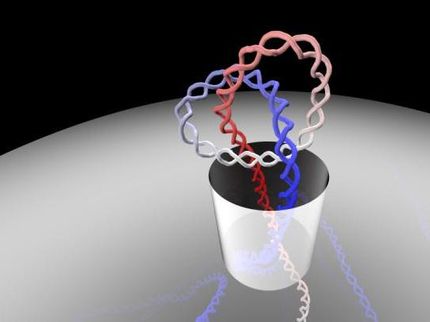Family member with special connections
How the chaperone Ssb connects to the ribosome
For 20 years, researchers have tried to find out why the chaperone Ssb is the only member of the widespread Hsp70-chaperone family that is able to bind directly to the ribosome. This question has now been answered at the University of Konstanz. Through the collaboration of the teams of Professor Elke Deuerling and Professor Christine Peter within the Collaborative Research Centre SFB 969 "Chemical and Biological Principles of Cellular Proteostasis" and the Research School chemical biology, the researchers were able to identify two regions within the Ssb chaperone that mediate direct contact to the ribosome and thus support the function of Ssb. "We can demonstrate that Ssb interacts with the ribosome mainly via positively charged amino acids", says Professor Elke Deuerling, speaker of the SFB 969, in whose team the binding sites of Ssb were discovered.
The chaperone Ssb is a member of the evolutionarily highly conserved Hsp70 chaperone family which is found in all living organisms. Hsp70 chaperones play a central role for correct protein folding – a process in which a protein adopts the right structure –, for preventing abnormal folding as well as for the transport of proteins. Ssb is the only family member that is in direct contact with the ribosome. It is active at a very early stage, when new proteins are being synthesised in the ribosome. "This ability is unique and cannot be detected at first glance when comparing Ssb with other Hsp70 chaperones. Only a few amino acids provide Ssb with this additional feature and show how flexible Hsp70 chaperones can be", explains molecular biologist Elke Deuerling, whose team member Dr. Anne Hanebuth significantly contributed to the discovery of the Ssb attachment sites in her doctoral thesis.
In several experiments, the biologists found out that the Ssb attachment sites are not essential under normal (lab-) conditions. If they are mutated, primarily nothing changes for the yeast cells. However, this is no longer the case if the co-chaperone RAC, another ribosome-bound complex that supports the function of Ssb, is absent. Without RAC, abnormal protein folding occurs in Ssb mutant cells, resulting in pronounced cellular defects. "We believe that these multivalent interactions with direct attachment sites and the cooperation with RAC allow the chaperone Ssb to position itself at the ribosome in an optimal way", says Elke Deuerling. Finding this exact position at the ribosome is of crucial importance for the effectiveness of the chaperone.
The ribosome-bound chaperone Ssb can only be found, in contrast to the co-chaperone RAC, in fungi such as yeast. In higher cells, RAC probably cooperates with other Hsp70 chaperones. This is why the researchers assume that the RAC-Hsp70-chaperone system is generally very important for correct folding of proteins and for keeping the cells fit. "How the RAC-Hsp70 system operates in higher cells and which effects it has on proteins relevant for diseases, will be a huge topic in the SFB", says Elke Deuerling. She further comments on the Ssb-chaperone results: "It was great team work within the University of Konstanz and with renowned teams from Heidelberg and Stanford. Computer simulations of the molecular dynamics of Ssb provided important indications of molecular interactions within the Ssb protein. This led to hypotheses about the ribosome interaction, which we have studied using further genetic, biochemical and kinetic approaches. So, step by step, we were able to achieve our results."
Original publication
Marie A. Hanebuth, Roman Kityk, Sandra J. Fries, Alok Jain, Allison Kriel, Veronique Albanese, Tancred Frickey, Christine Peter, Matthias P. Mayer, Judith Frydman & Elke Deuerling; "Multivalent contacts of the Hsp70 Ssb contribute to its architecture on ribosomes and nascent chain interaction"; Nature Comm.; 2016
Original publication
Marie A. Hanebuth, Roman Kityk, Sandra J. Fries, Alok Jain, Allison Kriel, Veronique Albanese, Tancred Frickey, Christine Peter, Matthias P. Mayer, Judith Frydman & Elke Deuerling; "Multivalent contacts of the Hsp70 Ssb contribute to its architecture on ribosomes and nascent chain interaction"; Nature Comm.; 2016
Topics
Organizations
Other news from the department science
These products might interest you

Kjel- / Dist Line by Büchi
Kjel- and Dist Line - steam distillation and Kjeldahl applications
Maximum accuracy and performance for your steam distillation and Kjeldahl applications

AZURA Purifier + LH 2.1 by KNAUER
Preparative Liquid Chromatography - New platform for more throughput
Save time and improve reproducibility during purification

Get the analytics and lab tech industry in your inbox
By submitting this form you agree that LUMITOS AG will send you the newsletter(s) selected above by email. Your data will not be passed on to third parties. Your data will be stored and processed in accordance with our data protection regulations. LUMITOS may contact you by email for the purpose of advertising or market and opinion surveys. You can revoke your consent at any time without giving reasons to LUMITOS AG, Ernst-Augustin-Str. 2, 12489 Berlin, Germany or by e-mail at revoke@lumitos.com with effect for the future. In addition, each email contains a link to unsubscribe from the corresponding newsletter.

























































